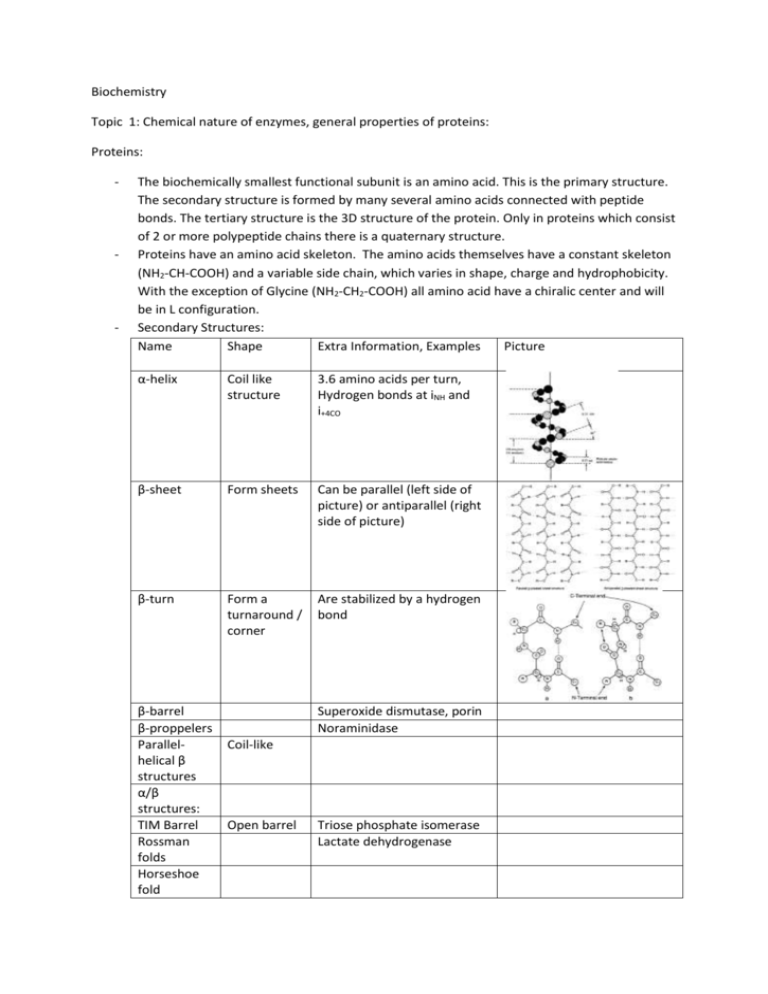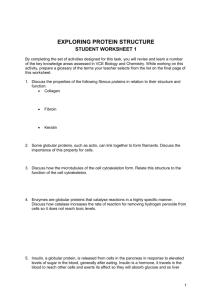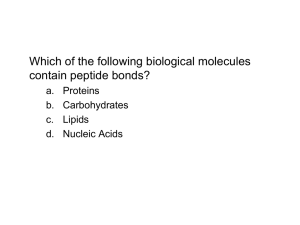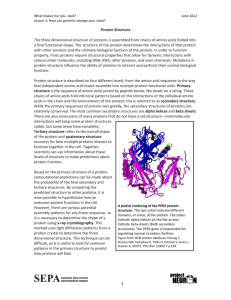Biochemistry Topic 1: Chemical nature of enzymes, general
advertisement

Biochemistry Topic 1: Chemical nature of enzymes, general properties of proteins: Proteins: - - - The biochemically smallest functional subunit is an amino acid. This is the primary structure. The secondary structure is formed by many several amino acids connected with peptide bonds. The tertiary structure is the 3D structure of the protein. Only in proteins which consist of 2 or more polypeptide chains there is a quaternary structure. Proteins have an amino acid skeleton. The amino acids themselves have a constant skeleton (NH2-CH-COOH) and a variable side chain, which varies in shape, charge and hydrophobicity. With the exception of Glycine (NH2-CH2-COOH) all amino acid have a chiralic center and will be in L configuration. Secondary Structures: Name Shape Extra Information, Examples Picture α-helix Coil like structure 3.6 amino acids per turn, Hydrogen bonds at iNH and i+4CO β-sheet Form sheets Can be parallel (left side of picture) or antiparallel (right side of picture) β-turn Form a turnaround / corner Are stabilized by a hydrogen bond β-barrel β-proppelers Parallelhelical β structures α/β structures: TIM Barrel Rossman folds Horseshoe fold Superoxide dismutase, porin Noraminidase Coil-like Open barrel Triose phosphate isomerase Lactate dehydrogenase - The tertiary structure will be a 3 dimensional structure which will be the most stable structure (ΔGF < ΔGD). The 3D structure depends on the primary structure and if there has ben an error during translation or transcribtion or there has been a DNA mutatuin the most stable 3d structure might not be achieved this might result in a less or even inactive protein. Hydrophobic amino acids will be in the core of the protein, hydrophilic will be presented on the outside to achive the most stable conformation. This conformation will be affected by attractive and repulsive forces : Attractive force: Discribtion Example Covalent bond Equal sharing of an electron Peptide and disulfide pair by 2 atoms. bonds, c-c Coordinate covalent bond Unequal sharing of an Fe2+ in hemoglobin electron pair by 2 atoms. The electron pair comes originally just from one atom. Electronpair donor is the ligand or lewis base and the acceptor the central atom or lewis acid. Important in interactions between Transition metals and organic ligands Ionic interactions Electrostatic attraction These bonds are formed between 2 groups of between positively charged different charge. (a-ammonium, eammonium, guanidinium, and imidazolium) side chains and negatively charged (ionized forms of ot-carboxyl, fl-carboxyl, ycarboxyl, phosphate, and sulfate) groups. Hydrogen bonds Sharing of a hydrogen atom N-H (peptide nitrogen, between two imidazole, and indole),-SH electronegative atoms that (cysteine),- OH (serine, have unbounded electrons. threonine, tyrosine, and hydroxyproline),- NH2 andNH~- (arginine, lysine, and oe-amino), and-CONH2 (carbamino, asparagine, and glutamine). Groups capable of sharing a hydrogen atom include COO- (aspartate, glutamate, and otcarboxylate),-SCH3 (methionine),-S-S (disulfide), and/~ C=O (in peptide and ester linkages). Van der Waals forces A fixed dipole in one Nonpolar interior structure molecule that induces of proteins. rapidly oscillating dipoles in Hydrophobic interactions Repulsive Forces Electrostatic repulsion Van der Waals repulsive forces - - - another molecule through distortion of the electron cloud. The positive end of a fixed dipole will pull an electron cloud toward it; the negative end will push it away. Strength depends very much on the distance. They cause nonpolar side chains (aromatic rings and hydrocarbon groups) to cling together in polar solvents, especially water. These interactions do not produce true "bonds," since there is no sharing of electrons between the groups involved. The groups are pushed together by their "expulsion" from the polar medium. important in lipid-lipid interactions in membranes This occurs between charged groups of the same charge. It is the opposite of ionic forces. They operate between atoms at very short distances from each other and result from the dipoles induced by the mutual repulsion of electron clouds. Since there is no involvement of a fixed dipole (in contrast to van der Waals attractive forces), the dependence on distance in this case is even greater. Membrane Proteins have a sequence of hydrophobic amino acids that will be inside the lipid bilayer membrane as the phospholipids are hydrophobic. Some will cross the membrane several times others only once. Cytosolic proteins are membrane proteins which do not cross the membrane but are only attached to one side of the membrane. Proteins can be separated according to their size, charge at a specific pH, MW, solubility or affinity to other substances Proteins have domains (parts with specific functions) The isoelectric point - pI – is the pH at which the net charge of the protein equals zero. At this point the Protein will loose all its “connections” with water molecules and sink to the bottom. Proteins can have additional groups or substances o o o o o o Lipoproteins Glicoproteins (Ig) Phosphoproteins (Casein) Hemoproteins (hemoglobin) Flavoproteins (succinate dehydrogenase) Methaloproteins (ferittin – Fe, Alcohol dehydrogenase – Zn, Calmodulin – Ca) Enzymes: - - Enzymes are proteins. They catalyze chemical reactions within the body: E+S->ES->EP->E+P. They can catalyze reactions in both ways and are very specific to the substrate they work on. Sometimes the enzymes need some inorganic cofactors for their proper action: Fe2+ or Fe3+ In peroxidase, K+ in pyruvate kinase, Mg2+ (in hexokinase, glucose-6-phosphatase, pyruvate kinase), Mn2+ (ribonucleotide reductase), Ni2+ (urease), Zn2+ (carbonic anhydrase, carboxypeptidase A and B) MW of proteins can vary between 12kDa to 1000kDa and even more. Terms: Configuration: The absolute arrangement of atoms around an atom. This arrangement can not be altered in any way without breaking a covalent bond (for example D and L chiral conformers) Conformation: The relative arrangement of atoms around an atom. This arrangement can be altered without breaking a bond (non chiral conformers can cahinge the relative position their atoms without breaking a covalent bond)










